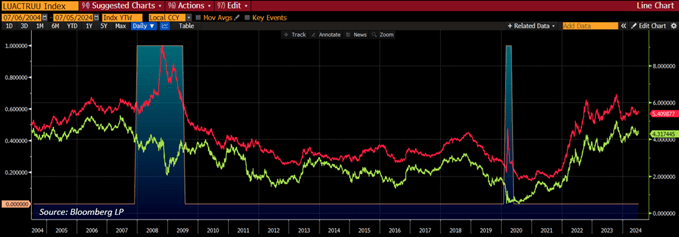A recession is coming
- 07.08.24
- Markets & Investing
- Commentary
Drew O’Neil discusses fixed income market conditions and offers insight for bond investors.
It’s inevitable. A recession is coming. Whether it gets here next month, next quarter, next year, or next decade will be continuously debated until it arrives. Yet, one thing that everyone will agree on is that we will have another recession eventually. Recessions are a natural part of the economic cycle. While they can’t be avoided, knowing what a recession might look like can help prepare investors and hopefully limit surprises during an economic downturn. When it comes to the corporate bond market, being prepared for how spreads might react will hopefully help keep you calm, remain focused on your long-term plan, and not get caught up in the hype and volatility that generally surrounds recessions.
The spread for a corporate bond is the difference in the bond’s yield and its benchmark’s yield (US Treasury with similar/same maturity). This spread represents the additional “reward” (yield) an investor receives in return for taking on additional credit risk. Investment-grade spreads are currently near their lowest levels of the past 20 years with the spread of the Bloomberg US Corporate Bond Index at ~91 basis points (average over the past 20 years is ~153 basis points). When the economy goes through a recession, spreads tend to widen as more credit risk is priced into the corporate bond market. The chart below shows this trend. The red line represents investment-grade corporate bond spreads over the past 20 years and the shaded regions show recessionary periods.
While spreads tend to widen in a recession, benchmark (Treasury) yields tend to fall. Historically, spreads have widened by a larger margin than Treasury yields fall which means that despite Treasury yields falling, corporate bond yields still move higher. This relationship is shown in the chart below. The red line represents the average yield of the Bloomberg US Investment-Grade Corporate Bond Index and the green line represents the 10-year Treasury yield. As in the first chart, the shaded regions are recessionary periods.
Given this historical groundwork, there are a few takeaways that investors should note with regards to what they might expect in the next recession. First, as corporate bond yields rise and Treasury yields fall, corporate bonds will underperform (from a total return perspective) both the Treasury market and many broader market indexes. The inverse relationship between prices and yields means that corporate bonds will fall in price if their yields rise while Treasuries will increase in price as their yields fall. Given the large weighting of Treasuries in most broad market indexes (the Bloomberg Aggregate index is currently ~43% in US Treasuries), corporate bonds will likely underperform the “market”. For investors with a portfolio of individual bonds, the important thing to remember is that this outperformance or underperformance does not have any effect on performance or return in the long-term. If buying and holding to maturity, interim price movement does not affect the investor unless they choose to sell prior to maturity. This leads to another important takeaway: the wider spreads tend to be temporary and snap back to pre-recession levels fairly quickly and continue lower from there.
Don’t let short-term market swings affect your long-term plan. If the fixed income portion of your portfolio is intended to be the ballast of your portfolio, remain calm in the face of volatility. Try to ignore market commentary from total return investors who measure themselves quarter-to-quarter. These “trade” ideas are generally short-term market plays rather than long-term strategies. For many investors, the spike in yields could present an opportunity for those willing to put money to work in the face of a recession. Following the past two recessions, yields have generally been lower post-recession than pre-recession. With yields near their highs of the past two decades and a recession potentially around the corner, locking in yields now with longer maturity bonds is likely in the best interest of many investors.
The author of this material is a Trader in the Fixed Income Department of Raymond James & Associates (RJA), and is not an Analyst. Any opinions expressed may differ from opinions expressed by other departments of RJA, including our Equity Research Department, and are subject to change without notice. The data and information contained herein was obtained from sources considered to be reliable, but RJA does not guarantee its accuracy and/or completeness. Neither the information nor any opinions expressed constitute a solicitation for the purchase or sale of any security referred to herein. This material may include analysis of sectors, securities and/or derivatives that RJA may have positions, long or short, held proprietarily. RJA or its affiliates may execute transactions which may not be consistent with the report’s conclusions. RJA may also have performed investment banking services for the issuers of such securities. Investors should discuss the risks inherent in bonds with their Raymond James Financial Advisor. Risks include, but are not limited to, changes in interest rates, liquidity, credit quality, volatility, and duration. Past performance is no assurance of future results.
Investment products are: not deposits, not FDIC/NCUA insured, not insured by any government agency, not bank guaranteed, subject to risk and may lose value.
To learn more about the risks and rewards of investing in fixed income, access the Financial Industry Regulatory Authority’s website at finra.org/investors/learn-to-invest/types-investments/bonds and the Municipal Securities Rulemaking Board’s (MSRB) Electronic Municipal Market Access System (EMMA) at emma.msrb.org.



